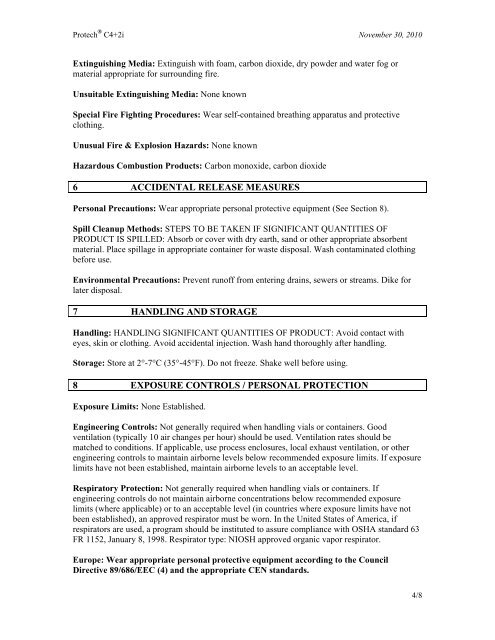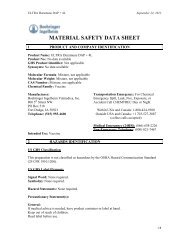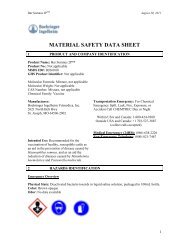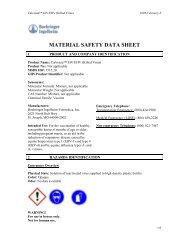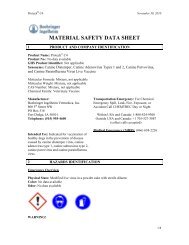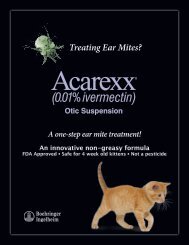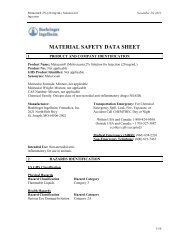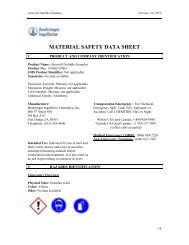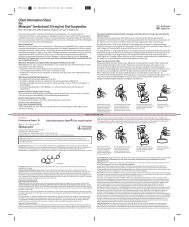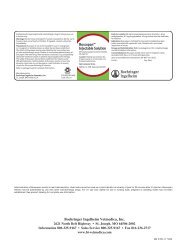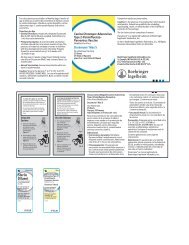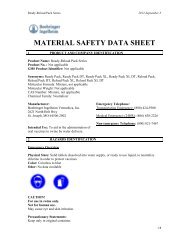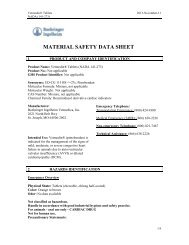Protech C4+2i Nov.docx - Boehringer Ingelheim Vetmedica
Protech C4+2i Nov.docx - Boehringer Ingelheim Vetmedica
Protech C4+2i Nov.docx - Boehringer Ingelheim Vetmedica
You also want an ePaper? Increase the reach of your titles
YUMPU automatically turns print PDFs into web optimized ePapers that Google loves.
<strong>Protech</strong> ® <strong>C4+2i</strong> <strong>Nov</strong>ember 30, 2010Extinguishing Media: Extinguish with foam, carbon dioxide, dry powder and water fog ormaterial appropriate for surrounding fire.Unsuitable Extinguishing Media: None knownSpecial Fire Fighting Procedures: Wear self-contained breathing apparatus and protectiveclothing.Unusual Fire & Explosion Hazards: None knownHazardous Combustion Products: Carbon monoxide, carbon dioxide6 ACCIDENTAL RELEASE MEASURESPersonal Precautions: Wear appropriate personal protective equipment (See Section 8).Spill Cleanup Methods: STEPS TO BE TAKEN IF SIGNIFICANT QUANTITIES OFPRODUCT IS SPILLED: Absorb or cover with dry earth, sand or other appropriate absorbentmaterial. Place spillage in appropriate container for waste disposal. Wash contaminated clothingbefore use.Environmental Precautions: Prevent runoff from entering drains, sewers or streams. Dike forlater disposal.7 HANDLING AND STORAGEHandling: HANDLING SIGNIFICANT QUANTITIES OF PRODUCT: Avoid contact witheyes, skin or clothing. Avoid accidental injection. Wash hand thoroughly after handling.Storage: Store at 2°-7°C (35°-45°F). Do not freeze. Shake well before using.8 EXPOSURE CONTROLS / PERSONAL PROTECTIONExposure Limits: None Established.Engineering Controls: Not generally required when handling vials or containers. Goodventilation (typically 10 air changes per hour) should be used. Ventilation rates should bematched to conditions. If applicable, use process enclosures, local exhaust ventilation, or otherengineering controls to maintain airborne levels below recommended exposure limits. If exposurelimits have not been established, maintain airborne levels to an acceptable level.Respiratory Protection: Not generally required when handling vials or containers. Ifengineering controls do not maintain airborne concentrations below recommended exposurelimits (where applicable) or to an acceptable level (in countries where exposure limits have notbeen established), an approved respirator must be worn. In the United States of America, ifrespirators are used, a program should be instituted to assure compliance with OSHA standard 63FR 1152, January 8, 1998. Respirator type: NIOSH approved organic vapor respirator.Europe: Wear appropriate personal protective equipment according to the CouncilDirective 89/686/EEC (4) and the appropriate CEN standards.4/8


